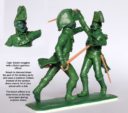Perry Miniatures: Neue Previews
Perry Miniatures präsentieren neue Preview Bilder auf Facebook.
Captain Richard Kenah RN and the taking of Banda-Neira75mm figures sculpted by Alan PerryWeapons designed by Rob McFarlaneYou may remember Alan had made a 75mm figure of an ancestor about ten years ago. There were two other military ancestors discovered at the same time. Alan has now made a second model. This time it’s a naval office; Captain Richard Kenah RN. He was brother-in-law to Captain David Gregory, the original ancestor Alan made.Captain Richard Kenah was our five times great uncle.His exploits read like a boys own adventure. He was described as a ‘gallant officer’ as well as a bit of a ‘firebrand’. Alan has picked this action at Banda- Neira as the subject for the diorama.The figures are Capt. Kenah in a life and death struggle with a Dutch officer of the garrison of fort Belgica. An infantryman from the 1st Madras European Infantry and a seaman, armed with a boarding pike, assist.These are just greens, as you can see, at the moment, but will be available at some point in resin.The following is worth a read and would also make for a great game….The taking of Banda-Neira 1810. A hazardous attempt!A quick introduction is needed before the extracts from the official Naval History.On the 10th June 1810 a small flotilla of three ships; 18-pounder 36-gun frigate Caroline, Captain Christopher Cole, 38-gun frigate Piémontaise, Captain Charles Foote, 18-gun brig-sloop Barracouta, Captain Richard Kenah, left Prince of Wales’s island, in the Straits of Malacca to capture the Island of Banda-Neira (Indonesia); the Dutch seat of government in the East Indies.During the stormy night of 9th August, 400 seamen, marines and soldiers of Madras European regiment boarded boats and set off from the flotilla which had dropped anchor three miles from the island. Due to the storm only 180 men, out of 400 assembled at point of rendezvous but Capt. Cole decided to carry on with the mission anyway!‘‘The group of islands, of which Banda-Neira is the capital, are 10 in number; six of which are named, Lontor, or Great Banda, Goonong-Api, Rosensgen, Pulo-Ay, and Pulo-Rhun. Banda-Neira is about two miles long and about three quarters of a mile wide; is extremely mountainous, and contains many excellent positions for repelling an invading force. At the time in question it possessed 10 sea-batteries, exclusive of Casteel-Belgica and Casteel-Nassau. The first of these castles, mounting 52 pieces of heavy cannon, commanded the other, as well as all the sea-defences at that extremity of the island, and was deemed, by the Dutch at least, an impregnable fortress; and the whole number of guns mounted for the defence of the island was 138. The garrison of Banda-Neira, as we shall by and by satisfactorily show, amounted to 700 regular troops, and at least 800 militia ; making a total of 1500 men. The party, now rapidly and silently advancing to surprise this force, consisted of 140 British seamen and marines, and about 40 soldiers of the Madras European regiment, under the command, as already stated, of Captain Cole, assisted by Captain Kenah, and by the following officers: Lieutenants Thomas Carew, Samuel Allen, George Pratt, Robert Walker, and Edmund Lyons, of the navy, Captain-lieutenant Nixon, Lieutenants Charles W. Yates, Philip Brown, and William Jones Daker, and ensign Charles Allen, of the Madras troops.Just as a black cloud, attended by wind and rain, had thrown a temporary darkness over the island of Banda-Neira, the British boats grounded on a coral reef, situated within 100 yards of the shore, and, although unknown at the time, directly opposite to the battery of Voorzigtigheid, mounting 10 long 18-pounders. Such, however, was the violence of the storm that the garrison at this battery remained in utter ignorance of what was going on so near to them; and the officers and men, leaping into the water, launched their boats over the reef. Shortly afterwards the British landed in a small sandy cove bordered with jungle; and the men were quickly formed, as well as the pitchy darkness of the morning would admit. That done, Captain Kenah and Lieutenant Carew, at the head of a party of pikemen, advanced to take the battery in the rear. This service was so promptly and effectually executed, that the sentinel was killed, and an officer and 60 men made prisoners, without the firing of a pistol, although the enemy was at his guns with matches lighted. Captain Kenah had been directed to storm the next sea-battery, also mounting ten 18-pounders; but Captain Cole, being resolved to take the bull by the horns, or, in other words, to attempt carrying the castle of Belgica by a coup-de-main, recalled Captain Kenah and his party, and, leaving a small guard at the captured battery, pushed on, with the aid of one of his native guides, through a narrow path that skirted the, town, towards the Dutch citadel, about half a mile distant.The sound of the bugle was now spreading the alarm over the island; but, favoured by the storm that was raging over head, and making a rapid march, the British arrived within 100 yards of the citadel-ditch before they were discovered. An ineffectual fire of musketry was now opened from the ramparts. Regardless of this, the brave fellows rushed up the steep ascent; and, placing their scaling-ladders between the guns upon the outer pentagon, which, owing to the rain, burnt priming, were in an instant in possession of the lower works. The ladders were quickly hauled up and placed against the inner wall, but were found too short. This appeared to inspire the besieged with fresh courage, and three guns and several volleys of musketry were discharged; but the stormers soon found another way into the heart of the citadel. Just at this moment the gate was opened by the Dutch guard, to admit the Colonel-commandant and three other officers, who lived in houses at the foot of the hill. At that gateway the British now made their rush, The Dutch colonel fell, covered with honourable wounds; and after a slight skirmish, in which 10 others of the garrison shared the fate of their commanding officer, the British colours waved at the flagstaff of the castle of Belgica.„With such examples,“ says Captain Cole, in allusion to his officers,“ our brave fellows swept the ramparts like a whirlwind, and, in addition to the providential circumstance of the service being performed with scarcely a hurt or wound, I have the satisfaction of reporting, that there was no instance of irregularity arising from success.“ A part of the garrison, in the panic that prevailed, escaped over the walls; and the remainder, amounting to four officers and about 40 artillery-men, surrendered rendered themselves prisoners. Just as all this had been accomplished, „the day beamed on the British flag,“ and discovered to the new garrison of Belgica, the fort of Nassau, the town, and the different sea-defences, at their feet.In the course of this day 1500 regulars and militia, 400 of the former from the north point, laid down their arms on the glacis of Fort Nassau; a clear proof, coupled with the manifest strength of the defences, that the force of Banda-Neira had not been overrated.Viewed in every light, the taking of the Banda isles was an achievement of no common order. Where are we to find, even in the annals of the British navy, more skill and perseverance than was employed in overcoming the difficulties of the navigation to the scene of conquest? Or where a greater share of address and valour, than was displayed by Captain Cole and his 180 brave associates, more than three fourths of them seamen and marines, in the crowning act of their bold exploit?’’From The Naval History of Great BritainBy William James 1837Death of Capt. Richard Kenah RN in 1814, Virginia ,USARichard went on to command the bomb ship Aetna which was heavily involved in the coastal bombardments of America in the War of 1812, including the bombardment of Fort McHenry (Baltimore). However he met his end in an amphibious assault the 3rd of October, on a tributary of the Potomac, when the troops were placed into boats, and sent up Coan River.‘On their way up, two soldiers were wounded, and Captain Kenah of the Ætna, a gallant young officer, killed, by musketry from the shore. Against so powerful a force, when once landed, the few militia could not be expected to stand: they fired a volley and fled, and the troops advanced past Northumberland court-house, five miles into the interior.’From The Naval History of Great BritainBy William James 1837
Quelle: Perry Miniatures auf Facebook











Kommentare